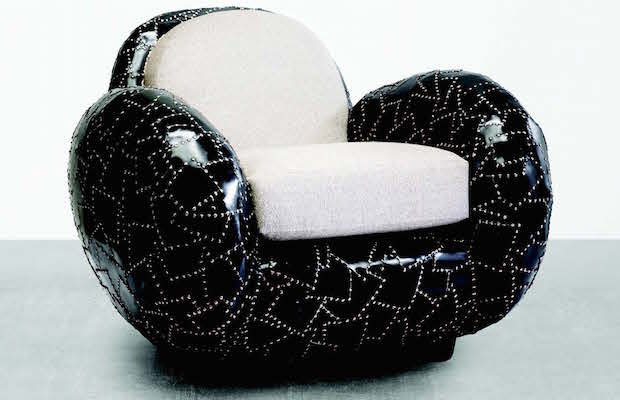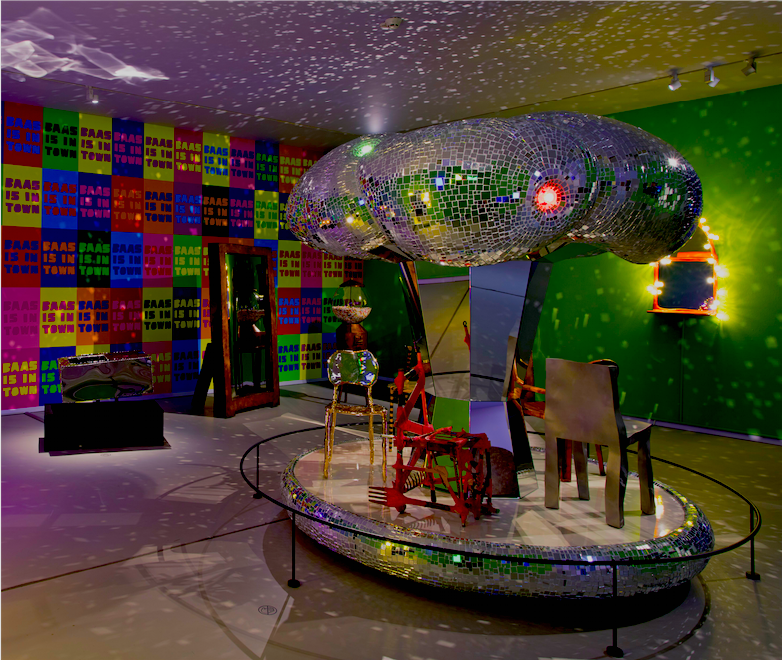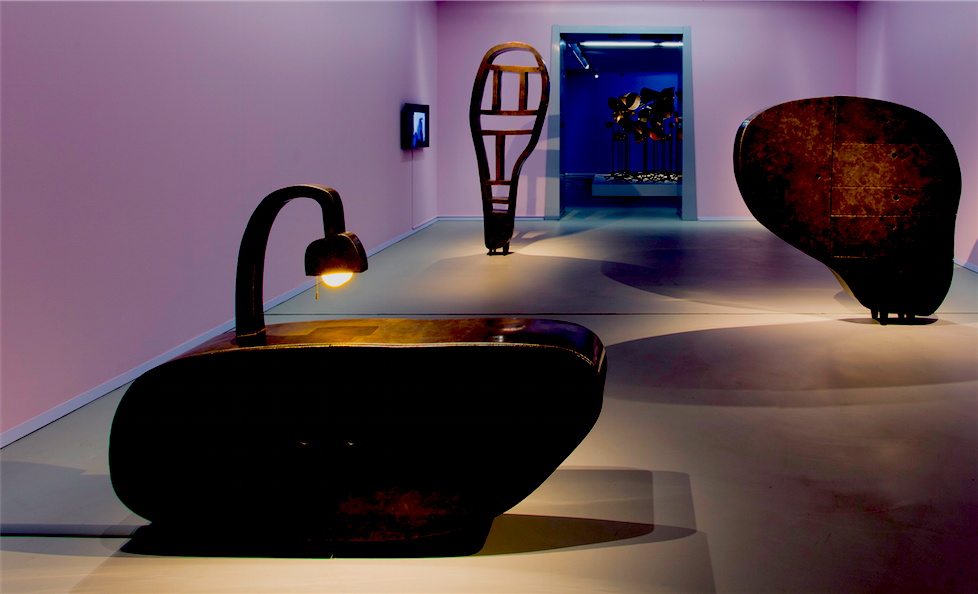 © Adrien Millot
© Adrien Millot
Feature
The Irony and the Ecstasy of Maarten Baas
MAARTEN BAAS IS SITTING IN A CHAIR that is plopped on the sidewalk in front of an old warehouse building next to Milan’s Central Station. It’s a perch reminiscent of the stoop-sitters you’d find in many urban neighborhoods in the years before air-conditioning took hold—there’s something ageless and conversational about it. He’s wearing the squished-down Reinhard Plank hat that has lately become part of his trademark look. A group of students approach him, tentatively but also a bit giddy at the sight. A collector and gallery owner stop by to talk, followed by any number of others. He’s a reluctant, yet willing, sidewalk celebrity. He is also currently the subject of a solo exhibition—Hide & Seek: Maarten Baas—at the Groninger Museum in the Netherlands. This is his first museum retrospective, which is noteworthy since he’s just thirty-nine, and it bears all the marks of his work and personality, both of which are simultaneously exuberant and outgoing, yet inscrutable and introspective, really, just as the name implies.

Anton Corbijn Photo
On this particular sunny day, Baas is holding court in front of his Milan Salone del Mobile installation, May I Have Your Attention Please? Though it revolves around a limited edition of eight colorful mismatched chairs—each with a subtly different shape for the back—for the Amsterdam-based design company Lensvelt, the installation is much more than a product debut. It is a conceptual offering, a comment on the clamor for attention that is the overriding culture during this massive international furniture fair. Here the chairs are surrounded by a gaggle of pre-programmed megaphones, though the sounds they emit are whispers instead of the more expected shouts. “Whatever I do, it’s always slightly off,” Baas says.

This installation view of the Hide & Seek exhibition at the Groninger Museum shows pieces from Baas’s Smoke collection, including a 2004 charred Ettore Sottsass Carlton room divider and a 2016 charred Marc Newson Wood chair. Hide & Seek, Maarten Baas, Groninger Museum 2017/Marten de Leeuw Photo
What he does may be slightly “off,” but it’s also always unexpected. Baas is part designer, part artist, part social commentator, and part provocateur. For his graduation project from the Design Academy Eindhoven in 2002, he burned (actually charred but not beyond recognition) chairs and then refinished them with an epoxy resin to make them usable again, at first selecting antique furniture to burn in order to explore the enigmatic question of permanence. The project captured immediate attention, especially from Marcel Wanders, who added the Smoke line to his offerings at Moooi, and from design rainmaker Murray Moss, who showed Baas’s work at his now-closed gallery in New York’s SoHo neighborhood. In 2005 Baas designed the irrepressible and witty Hey Chair, Be A Bookshelf! in which he stacked chairs and other “random items” to form a bookshelf that, in turn, has become part of a number of important design collections.

Hide & Seek includes variations on several past Baas installations, including the 2017 May I Have Your Attention Please?. Hide & Seek, Maarten Baas, Groninger Museum 2017/De Leeuw Photo
Not many years passed, and Baas was named Design Miami’s 2009 Designer of the Year, and joined the impressive ranks of those represented by, and shown at, Carpenters Workshop Gallery, which now operates in Paris, London, and New York. By then he had expanded the Smoke series to include pieces by Antoni Gaudí, Gerrit Rietveld, Charles and Ray Eames, and Ettore Sottsass—and his work was already making its way into museum collections. (Baas is now represented in some thirty-eight museums worldwide.)
“With the burned chairs,” he says, “I meant to ask: What do we consider beautiful? Why do we keep things as they were? We don’t want things to change, but in a way that’s very unnatural. In my mind, I’m always searching for a balance.” That quest has taken him well beyond his Smoke series to work that is at once tactile and familiar yet conceptual and often even confounding. Baas has made childlike and yet utterly sophisticated furniture out of clay (for a series called Clay); he also designed a grandfather clock but substituted moving images for the face. (It initially featured a grandfatherly figure, if you will, changing the time by erasing the clock face and then writing in the new time; in a later series that he called Real Time he used himself as the timekeeper.) It is this push-pull of the expected and the unexpected, between certainty and uncertainty that propels him. “The clay furniture was rational and yet irrational,” Baas says. Likewise, he says, “A clock tells time precisely, but time isn’t always experienced that way. Time is both rational and irrational.”

Example from the Real Time collection, which debuted in 2009, installed at the Groninger Museum. Hide & Seek, Maarten Baas, Groninger Museum 2017/De Leeuw Photo

Example from the Real Time collection, which debuted in 2009, installed at the Groninger Museum. Hide & Seek, Maarten Baas, Groninger Museum 2017/De Leeuw Photo
Early on, Baas introduced a number of his projects at the Salone in Milan, but he abruptly stopped after debuting Real Time in 2009 and didn’t return to Milan for five years. In 2014 he showed up with a circus. Really. Baas was in the center of it all, dressed as a ringmaster and surrounded by funhouse mirrors (made in bronze, because little is as it might seem), cartoon-inspired gumball machines (also bronze), colorful games of chance, actors in clown garb, and much more, including hastily improvised pieces made of such materials as polystyrene and shown alongside pieces selected from the sophisticated and polished work he has done for Carpenters Workshop Gallery. The purpose was twofold: first, a subtle and not-so-subtle critique of the circus-like spree that he sees in Milan’s design week, the other far more ingenuous. “If you look at the circus,” he says, “there’s an inner joy, the joy you experience as kitsch but that also touches something very personal inside. That very ordinary circus kind of energy gets you in touch with your inner emotions as well.” It was a vessel for some serious cultural criticism of the instant “one-photo” (as he called it) social media culture that seems to dominate Salone.
Carpenters Workshop has shown some of Baas’s most intricate and elegant work. A 2016 exhibition in New York introduced his Carapace series of bronze and steel furniture—clublike lounge chairs, a desk, cupboard, and cabinets. He finished the metal with dark patinas and “stitched” pieces together, the stitches spot-welded dot by dot in a crazy-quilt pattern. The name and concept come from the hard shell that protects an array of creatures from turtles to beetles, while the robust rounded forms recall refrigerators of the 1950s, industrial design that Baas much admires. This past winter Baas introduced another collection at Carpenters called Close Parity, five brass-clad pieces based on “naive sketches” that look a bit precarious, and seem to defy gravity—though in fact they are balanced by counterweights. Says Baas, “In order to keep it balanced, it needs some engineering. To look that naive you need a lot of intelligence.”

The circus-themed Baas is in Town, a 2014 exhibition satirizing Milan design week, has been partially re-created for Hide & Seek. Hide & Seek, Maarten Baas/Groninger Museum 2017/De Leeuw Photo
The Carpenters show offered a sneak preview of the retrospective now on view at the Groninger (to September 24). Hide & Seek follows the trajectory of Baas’s still-young career from Eindhoven forward. The museum has an established relationship with him dating from 2010, when he designed a line of his clay furniture for its Mendini Restaurant. There are also fine examples of Clay on view in the exhibition, including a suite of standing fans as well as chairs and tables, along with his much-vaunted Smoke furniture. Also represented is New, Newer, Newest, from 2016, which proposed such natural interventions as a tree with a chair molded into it—a project shown as a large-scale model, since the real thing won’t fully materialize for some two hundred years. And though he insists that he is not preoccupied by time, or even the passing of time, several of his enigmatic Real Time clocks are on view, as well as the newer work for Carpenters Workshop, Carapace and Close Parity. The exhibition also features versions of both the Baas is in Town circus and May I Have Your Attention Please?—with the 101 Chairs for Lensvelt accompanied by whispering megaphones.

Furniture from the Close Parity series, 2016, are featured in Hide & Seek. Hide & Seek, Maarten Baas/Groninger Museum 2017/De Leeuw Photo
The juxtaposition of these last two is both funny and poignant. It’s a noisy world. And though his work poses any number of questions about past and future, Baas is in many ways old-fashioned, encouraging us to slow down, look back, and look forward, but also to appreciate the moment, appreciate now. That’s partly why he’s outside the converted warehouse in Milan, in a sociable pose. But he is the extroverted introvert, and when there’s a lull he wanders inside just to look at, and maybe take a few photos of, his installation. He’s alone, and quiet, though there’s still a din outside, and at that moment, the attention is his to embrace or eschew.

Carapace armchair, 2016. Welded patinated steel, alpaca, and wool. © Adrien Millot










